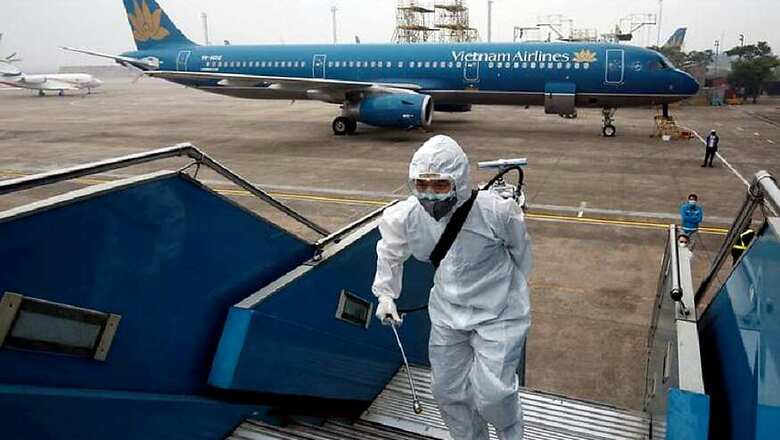
views
As the global aviation industry grapples with the largest demand shock in history, there are nudges from all quarters for governments to intervene and provide support to airlines. While the industry is no stranger to “black swan” events, the sheer magnitude of the coronavirus pandemic impact has left the industry with very few options.
For purposes of comparison, the 1990/1991 Gulf War resulted in a 7-9 per cent reduction in passenger demand; the SARS outbreak resulted in a 20 per cent decline in demand in Hong Kong; the 2004 Indian ocean earthquake/tsunami led to up to 35 per cent reduction in demand in the region; and the 2010 Eyjafjallajokull volcanic eruption resulted in a 20-30 per cent decline in demand in the region.
The 2020 Coronavirus outbreak, however, will surpass all of these. A demand decline of more than 50 per cent is forecast and is likely to go higher.
Decimation of Demand
Usually the demand shock is limited to a geography and demand takes time to dissipate. This time though, demand has simply evaporated. It does not help that entire countries are being closed off with extreme travel advisories. Currently, thirty countries have restrictions on foreigners flying in and this number is expected to rise. For airlines, especially global airlines, their marketplaces have effectively been shut.
Even where markets are open, the booking forecast looks bleak. Industry watchers have indicated that load-factors (which is the percentage of aircraft that are filled) are falling in the double digits.
Needless to say, no amount of cost cuts will suffice to make up for such an extreme decline in demand. The best option is to drastically cut capacity, ground aircraft and conserve cash. Airlines are doing just that.
Drastic Capacity Cuts
To deal with the situation airlines are cutting capacity and grounding aircraft. This time though the cuts are akin to using a hacksaw as opposed to a carving knife. Whether it is FinnAir or SAS, or AirFrance-KLM with capacity cuts of up to 90 per cent; or RyanAir that is cutting capacity by 80 per cent and may ground its entire fleet; or Cathay Pacific with capacity cuts of over 75 per cent; or Lufthansa with capacity cut of 50 per cent; or Delta Airlines and the decision to park 300 aircraft and cut capacity by 40 per cent; or United Airlines with capacity cuts north of 50 per cent.
The list is endless and more cuts are on the way. As of this writing, ten global airlines have announced a complete grounding of their fleet. Massive layoffs, bankruptcies and airline shutdowns are likely.
How a Recovery Will Look
All said and done, eventually folks will take to the skies again. But there is no denying that the nature of aviation has been changed forever. Whether it is visa policies, de-risking of supply chains and an uptick in remote-work or the use of technology – the nature of flying is set to change. In the medium term though, labour, capital and people flows will resume. And this effectively will constitute the recovery.
Two key questions are what shape the recovery of demand will take and how long the recovery will take. Each prior “black-swan” has seen a different nature of recovery and different timelines. The Oil crisis of 1979 took three years before global traffic returned to pre-crisis levels; the Gulf-War impact took six months to dissipate (note: this was limited to certain geographies while others were racing ahead); 9/11 took two years before global demand returned to pre-crisis levels; and the global financial crisis of 2008 took six to nine months (again certain geographies and emerging markets helped).
The past may give some ideas but it is worth repeating that the sheer magnitude and speed of the decline has not been seen previously in global aviation.
Shape of Recovery
Industry watchers and insiders, at least those who are thinking ahead, are looking to what shape the recovery will take. That is, how soon global traffic will revert to pre-crisis levels (on a country-level this will be significantly different than when looked at as a whole). A V-shaped recovery is actually the best case. This was seen in the Oil Crisis of 1979 where global air travel demand started to rise post the crisis. But this nature of recovery has all but been ruled out.
Chances are of a “U” shaped recovery. This was seen after the terrorist attacks of Sept 11, 2001. A situation where demand will continue to fall, flatten out and then start to rise. When it comes to how long the recovery will take, this is anybody’s guess. There are simply too many variables to forecast a timeline. And thus the decision of airlines to ground aircraft. Because even when demand picks up, the only way to entice travellers will be via price.
Effectively, airlines will be buying their sales for a while before they return to a profitability zone. Some promoters may also use this as an excuse to demand sops or to exit the business completely.
Post-recovery Aviation to Change Forever
Even when traffic levels start to stabilize, aviation as we know it will not be the same. A revision of business models and a rethink “high-density” configurations may be on the horizon. Short ground times and quick turning around of aircraft may not be feasible anymore if sanitizing the cabin after each flight becomes mandatory. A comparison of costs of new aircraft versus cost of old aircraft (given price of fuel) may lead to different fleet decisions. A revision of regulations to include other mitigation measures (with cost impacts) is also likely.
The most stressful and unpleasant element of travel, namely “airport security” may get an additional element of “health security.” “Market-access” that was conveniently doled out to foreign carriers via bilaterals and “open-skies” agreements may be revisied and aviation policy changes by countries is likely.
The author is an India market expert and has held a variety of roles within the aviation business. He is also a certified pilot with an instrument rating.




















Comments
0 comment